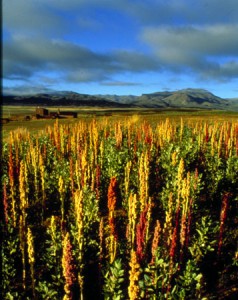In the New York Times Sunday, March 20th, 2011 International section page 5 under Obama Visits a Brazilian President Critical of U.S. Economic Policies is a picture of women at a local market in Batallas, Bolivia. The heading for this caption is “A Food’s Global Success Creates a Quandary at Homeâ€, “Quinoa is Now Too Expensive for Many Boliviansâ€.
This article and picture was so strategically placed under the article on the Obama administration, as I couldn’t help but immediate make the link between the United States and our economic policies that have enabled us to become consumers of other countries goods and services at a rate unlike many other nations. Here was an example of such. In the article by Simon Romero and Sara Shahriari the plight of quinoa as a food resource for so many Bolivians is slowly losing its original birthplace for harvest and consumption due to both economic and social changes. Economically the increase of processed foods and cheaper alternative grains in the country has had its market effect.
White rice and noodles are found at significantly less cost to the quinoa at $5 dollars a box.  A two pound bag of quinoa cost $4.85 compared to $1.20 for an equal size bag of noodles and $1.00 for a bag of white rice. As white rice and noodles outweigh the cost availability to buying quinoa these simple carbohydrates have also began to replace quinoa as a staple to the Bolivian diet. The trade off is significant, as we know quinoa as a complete protein or whole protein has vitamins and nutrients that can’t easily be reproduced by such substitutions. It’s by far an even trade. The Bolivian food tastes are being transformed by this change as it becomes less interesting to consumers.
Younger generations are replacing it at the table with their forks and mouths. After reading this article I was consumed by how easily I take for granted the access to good healthy food choices. I soak, sprout and boil my quinoa religiously consuming vast quantities. It is a staple to my diet. How fortunate am I that I can continue to have quinoa at my table and feed myself with this nutritious source. I can’t help but include it in my blessings tonight as I consciously ground myself in preparation of my meal of quinoa and steamed veggies.
Fair-trade resources One way to support Bolivian people and the distribution of quinoa is to shop responsibly for the product. If you can afford to buy from brands that sponsor fair trade practices it can make a difference. One example is Andean Naturals which I have bought and is very taste.
I usually buy my quinoa in bulk but on occasion I have bought their boxed product especially when I travel. According to their website they support 280 local farmers in a fair trade exchange for their product. Pictures of the results of their efforts can also be found at their quinoa pasta website Andean Dream. My cupboard typically contains this brand and another one called Ancient Harvest. I keep the two brands as I like to alternate. Andean Natural is a mix of quinoa with rice while Ancient Harvest pasta is mixed with corn so the texture is a bit heavier good for hearty vegetables and soups. I emailed them recently to check if they are fair-trade and will let you know in a follow-up blog once I hear back. If you really want to expand your use of fair-trade products or just want to verify your products with a national licensing source check out http://www.transfairusa.org/.  There is also a wonderful UK site for all your ethical shopping needs http://www.ethicalsuperstore.com/.



